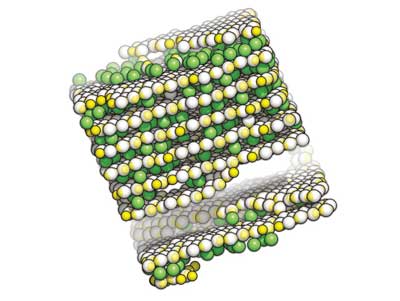| Posted: Jan 17, 2018 |
Solid and liquid at the same time
(Nanowerk News) There are many ways to create new, innovative materials. One of the most interesting is a process whereby tiny particles self-assemble to form complex structures. This process, referred to as ‘self-organisation’, opens up some remarkable opportunities as has now been demonstrated by computer simulations performed at TU Wien. Simple macromolecules are able to form layered systems that can be simultaneously solid and liquid within a wide temperature range.
|
Repulsive and attractive charges
|
|
‘The basic concept is one that is exploited widely in nature,’ explains Professor Gerhard Kahl of the Institute of Theoretical Physics at TU Wien. ‘Viruses and bacteria often exhibit surface charges. This means that they either attract or repel one another, depending on the type of charge they are carrying. As a result, selective bonding can occur between these entities, allowing them to assemble themselves into interesting, functional structures.’
|
|
A similar process is also possible with man-made particles – for example, small (colloidal) spheres to which a positive electrical charge is applied at two opposite surface regions. If the ambient conditions are appropriate, such particles can self-assemble to form a two-dimensional layer. The particles then become tightly packed, forming a hexagonal pattern, with the charged surface regions of the particles aligned so that they form strong attractive bonds. This bonding pattern makes the layer extremely stable.
|
 |
| Particles forming regular layers. (Image: TU Vienna)
|
|
As Emanuela Bianchi and Silvano Ferrari from Gerhard Kahl’s working group have demonstrated, this allows an interesting phenomenon to occur, namely that several such layers can then join together simultaneously. Additional particles can can then occupy positions between the layers, establishing strong bonds between these layer. These bonding particles fix the layers in place, meaning that they can no longer shift relative to one another; thus a stable, multi-layered structure is formed completely autonomously through self-organisation of random particles that happen to be passing by (Nanoscale, "Spontaneous assembly of a hybrid crystal-liquid phase in inverse patchy colloid systems").
|
Both solid and liquid: the mini chocolate wafer
|
|
The special characteristics of these structures become apparent when the temperature is raised: ‘The bonds within the individual layers are much stronger than the bonds between the layers,’ explains Gerhard Kahl. ‘If the temperature is increased, it is the weaker bonds between the layers that break first; the particles can then move freely as a liquid whilst the layers themselves remain stable.’ This effect is similar to a chocolate wafer in the summer heat, with liquid chocolate sandwiched between solid, stable wafer layers. ‘This is a remarkable phenomenon. We are dealing with a unique material that consists of only one type of particles, yet can form a structure that comprises both solid and liquid layers at the same time.’
|
|
This scenario can be observed over a wide temperature range; it is only when the temperature is so high that even the stable bonds within the individual layers are broken that the structure falls apart and melts completely. Until then, the system demonstrates an exceptional ability to self-heal: even when damaged, it is soon repaired automatically by randomly passing particles.
|
|
Experiments have already started to test the potential uses of these new ideas. There are many possible uses for structures of this kind. ‘Such structures would allow us to precisely control the transportation of particles via suble changes in temperature,’ says Gerhard Kahl. This could be used in medicine, for example, in order to transport medication to exactly the appropriate place in the body.
|

